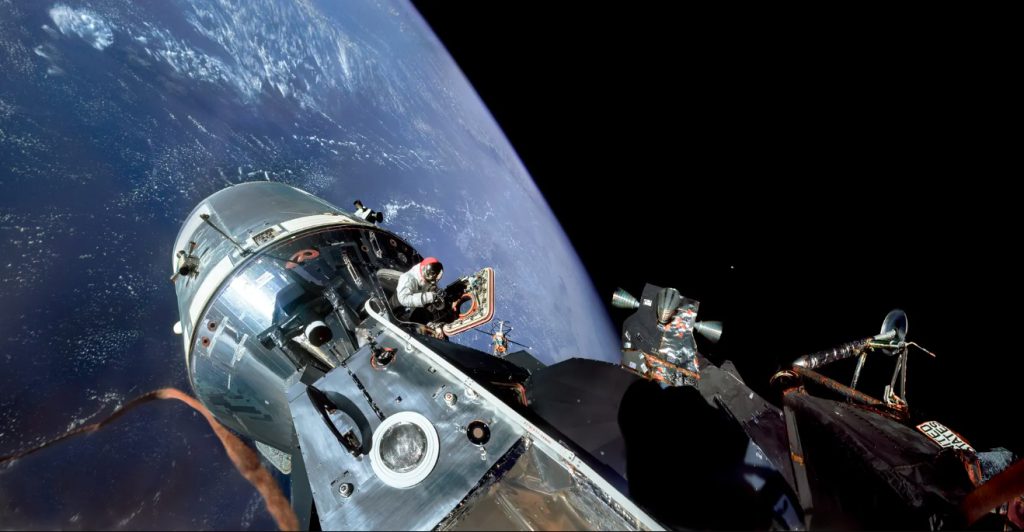Link About It: This Week’s Picks
Apollo mission photography restored, pulverizing glass for coastal restoration, bowfin regurgitalite and more

Recycling Glass into Sand and Gravel to Fight Climate Change
 Founded in 2020, Glass Half Full is a New Orleans-based startup that recycles glass to make sand and gravel to be used in disaster relief, construction, new products and boosting coastal restoration—an issue particularly pertinent to Louisiana where coastal degradation occurs aggressively. After sourcing discarded glass from their donation service, as well as local restaurants and businesses that they partner with, the company pulverizes the material (sifting out any unwanted components) until it reaches the desired consistency. The process, which was developed in co-founder Fran Trautmann’s backyard, is capable of making sand that is, as she says, “pretty close to the original sand.” Already, they’ve made over 10,000 pounds of recycled glass sand which was used to create a drain and rain garden for the Point-Au-Chien Tribe. Learn more about their impressive work at Reckon.
Founded in 2020, Glass Half Full is a New Orleans-based startup that recycles glass to make sand and gravel to be used in disaster relief, construction, new products and boosting coastal restoration—an issue particularly pertinent to Louisiana where coastal degradation occurs aggressively. After sourcing discarded glass from their donation service, as well as local restaurants and businesses that they partner with, the company pulverizes the material (sifting out any unwanted components) until it reaches the desired consistency. The process, which was developed in co-founder Fran Trautmann’s backyard, is capable of making sand that is, as she says, “pretty close to the original sand.” Already, they’ve made over 10,000 pounds of recycled glass sand which was used to create a drain and rain garden for the Point-Au-Chien Tribe. Learn more about their impressive work at Reckon.
Image courtesy of Glass Half Full
150-Million-Year-Old Fossilized Vomit Discovered in Utah
 In southeast Utah, paleontologists discovered 150-million-year-old fossilized vomit that offers new insight about Jurassic ecosystems. While surveying the Morrison Formation, a famous paleontological site, the team came across an odd pile of amphibian bones (including ones that were only 0.12 inches long) and regurgitalite (the fossilized form of vomit). Scientists suspect that a bowfin fish is likely behind the puke, as they were not only in existence during that time, but also have a tendency to vomit while being pursued by a predator. “There were three animals that we still have around today, interacting in ways also known today among those animals—prey eaten by predators and predators perhaps chased by other predators. That itself shows how similar some ancient ecosystems were to places on Earth today,” says John Foster, curator of the Utah Field House of Natural History State Park Museum and one of the co-authors of the study. Learn more about the rare find at KSL.
In southeast Utah, paleontologists discovered 150-million-year-old fossilized vomit that offers new insight about Jurassic ecosystems. While surveying the Morrison Formation, a famous paleontological site, the team came across an odd pile of amphibian bones (including ones that were only 0.12 inches long) and regurgitalite (the fossilized form of vomit). Scientists suspect that a bowfin fish is likely behind the puke, as they were not only in existence during that time, but also have a tendency to vomit while being pursued by a predator. “There were three animals that we still have around today, interacting in ways also known today among those animals—prey eaten by predators and predators perhaps chased by other predators. That itself shows how similar some ancient ecosystems were to places on Earth today,” says John Foster, curator of the Utah Field House of Natural History State Park Museum and one of the co-authors of the study. Learn more about the rare find at KSL.
Image courtesy of Brian Engh/Utah Division of State Parks
Sending Solar Panels to Space to One Day Power Homes on Earth
 The world’s largest solar technology company, Longi Green Energy Technology Co, is preparing to send its solar panels to space to test the feasibility of creating off-planet power stations that can fuel homes on Earth. By situating solar panels in space, where they are positioned with an unrestricted view of the sun, the company seeks to resolve a major drawback of solar power: panels can’t generate energy in the dark. The China-based company has already successfully tested their system which consists of converting solar power into microwave beams, transmitting those beams through the air to a receiver station and transforming beams into electricity. This first launch into orbit will critically test the possibilities of directly harnessing the sun’s power. Learn more about this at Bloomberg.
The world’s largest solar technology company, Longi Green Energy Technology Co, is preparing to send its solar panels to space to test the feasibility of creating off-planet power stations that can fuel homes on Earth. By situating solar panels in space, where they are positioned with an unrestricted view of the sun, the company seeks to resolve a major drawback of solar power: panels can’t generate energy in the dark. The China-based company has already successfully tested their system which consists of converting solar power into microwave beams, transmitting those beams through the air to a receiver station and transforming beams into electricity. This first launch into orbit will critically test the possibilities of directly harnessing the sun’s power. Learn more about this at Bloomberg.
Image courtesy of AFP/Getty Images/AFP
Viking Textiles Reveal Misconceptions About Women’s Power in Medieval Societies
 The understood role of North Atlantic Viking women is often domestic, placing them second to men. However, new studies reveal these assumptions were made with present-day bias and that women were integral to the evolution of Medieval societies. At the forefront of this research is Michèle Hayeur Smith, an anthropological archaeologist at Brown University who analyzed textiles from the era to unearth the lives of Viking women. For years, she counted each weave and weft thread, realizing that colorful and diverse Viking cloths started to became similar, indicating that there was a legal, standardized cloth (called vaðmál) that women made and traded to earn a major income. Not only did these women create a product that greatly contributed to Viking economies, they also adapted their weaving techniques due to climate change when temperatures dropped greatly and warmer clothes were life-saving. Examining cast-aside textiles, Hayeur Smith has revealed the power women had in Viking communities while upholding the importance of the craft. Learn more about this at Scientific American.
The understood role of North Atlantic Viking women is often domestic, placing them second to men. However, new studies reveal these assumptions were made with present-day bias and that women were integral to the evolution of Medieval societies. At the forefront of this research is Michèle Hayeur Smith, an anthropological archaeologist at Brown University who analyzed textiles from the era to unearth the lives of Viking women. For years, she counted each weave and weft thread, realizing that colorful and diverse Viking cloths started to became similar, indicating that there was a legal, standardized cloth (called vaðmál) that women made and traded to earn a major income. Not only did these women create a product that greatly contributed to Viking economies, they also adapted their weaving techniques due to climate change when temperatures dropped greatly and warmer clothes were life-saving. Examining cast-aside textiles, Hayeur Smith has revealed the power women had in Viking communities while upholding the importance of the craft. Learn more about this at Scientific American.
Image courtesy of Chase Stone
Remastered Photographs From The Apollo Space Missions
 NASA’s Apollo mission photographs have been widely circulated for decades, but now remastered versions of the images have been revealed. They appear in a new book called Apollo Remastered, which is filled with photographs from the archive, immaculately restored by Andy Saunders. It’s quite remarkable, when considering the sharpness of the original images, which—Tim Peake, an astronaut who introduces the book, says—is what sparked conspiracy theories in the first place. “Because of the lack of atmospheric haze, the clarity with which you can see in space is incredible. You can see very far and it makes judging distances hard,” he writes. “There’s no haze, no dust. Because of that there’s no scattering of light, so the shadow is crisp and sharp. This is what triggered so many conspiracy theories. People thought: ‘That’s the light you get in a studio.’ And they’re right, but you don’t get that outdoors on Earth. For me, that’s what’s so authentic about these pictures. I think: ‘This is what I relate to. This is space.'” Take a look at the stunning pictures, and read more from the book, at The Guardian.
NASA’s Apollo mission photographs have been widely circulated for decades, but now remastered versions of the images have been revealed. They appear in a new book called Apollo Remastered, which is filled with photographs from the archive, immaculately restored by Andy Saunders. It’s quite remarkable, when considering the sharpness of the original images, which—Tim Peake, an astronaut who introduces the book, says—is what sparked conspiracy theories in the first place. “Because of the lack of atmospheric haze, the clarity with which you can see in space is incredible. You can see very far and it makes judging distances hard,” he writes. “There’s no haze, no dust. Because of that there’s no scattering of light, so the shadow is crisp and sharp. This is what triggered so many conspiracy theories. People thought: ‘That’s the light you get in a studio.’ And they’re right, but you don’t get that outdoors on Earth. For me, that’s what’s so authentic about these pictures. I think: ‘This is what I relate to. This is space.'” Take a look at the stunning pictures, and read more from the book, at The Guardian.
Image courtesy of NASA/JSC/ASU/Andy Saunders
Link About It is our filtered look at the web, shared daily in Link and on social media, and rounded up every Saturday morning. Hero image courtesy of NASA/JSC/ASU/Andy Saunders











